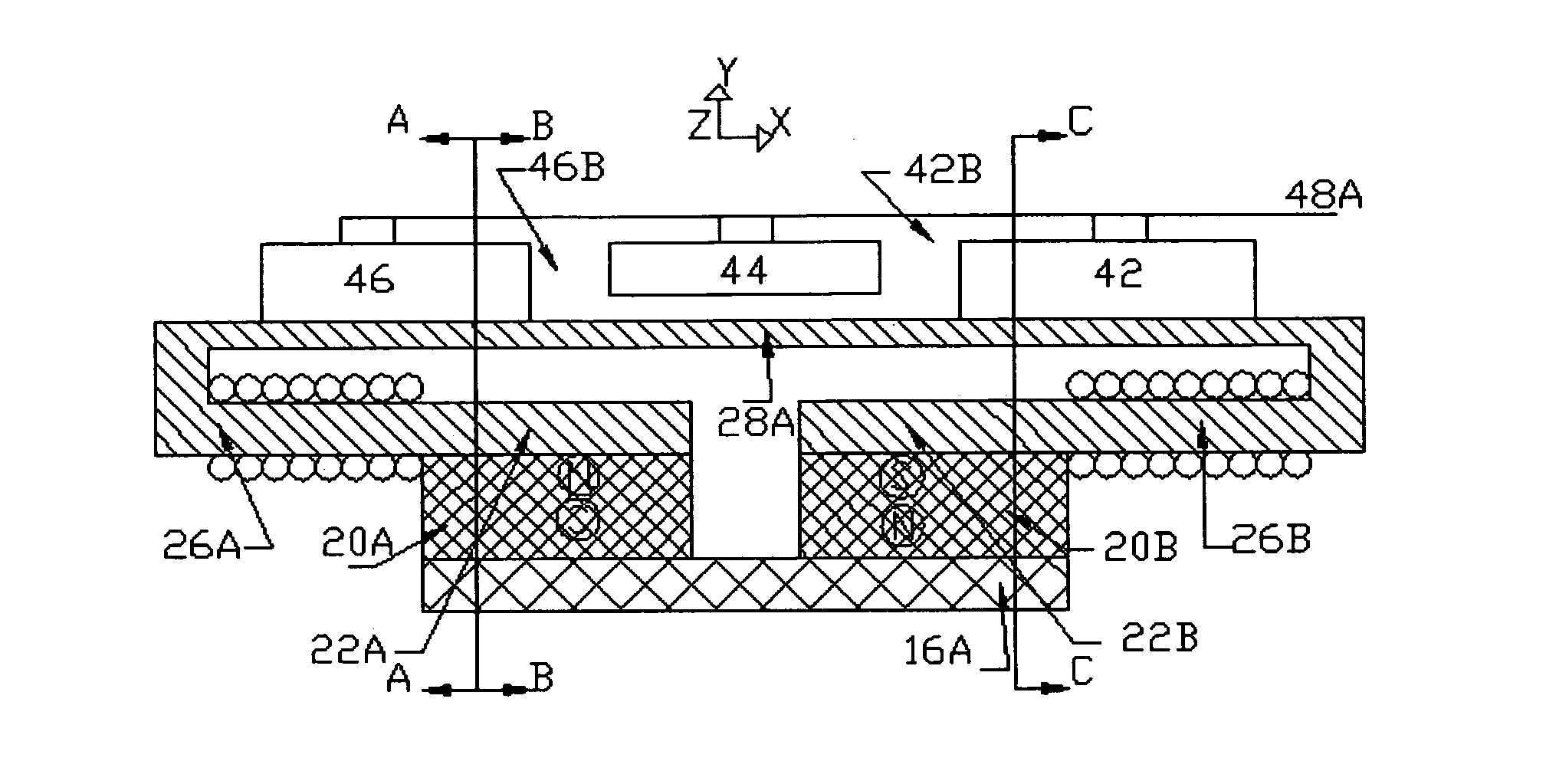Linear tape motor
a tape motor and tape drive technology, applied in the field of linear tape motors, can solve the problems of severe loss of expansion and contraction capability, its own problems, etc., and achieve the effects of improving the means of precision positioning objects in space, high force and power density, and operating efficiently and effectively
- Summary
- Abstract
- Description
- Claims
- Application Information
AI Technical Summary
Benefits of technology
Problems solved by technology
Method used
Image
Examples
case 1
[0041]Case 1 is the worst case because all the permanent magnet flux must be forced through a single path. This requires high performance soft magnetic material that will not saturate and requires the largest NI sufficient to drive the additional magnetic flux across the air gap without changing VPm. [Eqs. 6, 7, 8 are explained in ref. 3, Appendix B.]
Permanent magnet φpm=BmaxS.
All the flux is going through the back shoe 46 air gap.
Vpm+2NSISB=∅pmRair=Bmaxdμ0(eq.6)
This requires 2.65 amps in electromagnetic assistance.
Zero flux is going through the front shoe 42 air gap.
Vpm−NSISF=0 (eq. 7)
This requires 1.33 amps in electromagnetic blocking
Zero flux is going through the driver 44 air gap.
Vpm−NDID=0 (eq. 8)
This also requires 1.33 amps in electromagnetic opposition.
The power supply requirement is, then, 5.31 amps. These are reasonable numbers.
Case 2
[0042]In Case 2, the back shoe 46 is planted, the driver 44 is being driven downwards and the front shoe 42 is free to move. The available p...
case 2
g the Payload forward using magnetic force on the Driver. We assume the permanent magnet flux is equally distributed between the Back Shoe and the Driver.
∅B=∅D=∅PM2;BB=BD=BPM2∅F=0;BF=0
And from eq.9.
FB=FD=FPM22(6lbfforourexample)FF=0(P11)
case 3
g the system with power off and the Driver down.
∅B=∅D=∅F=∅PM3;BB=BD=BF=BPM3FB=FD=FF=FPM32(83lbfforourexample)(P12)
Cases 1 and 2 have mirror Cases in which the Front shoe is planted rather than the Back Shoe but, the relationships and values are unchanged.
Choosing drive flexure 46d, 42d spring stiffness to provide 2 lbf force at 0.010 deflection enables the 8 / 3 lbf available power off magnetic force to hold the driver 42 down during actuator rest and still drive it with 21 lbf·28.68=57.36 lbf.
Prototype drive would be>57.36 lbf. (P13)
Flexure Wedge Hold Forces.
[0053]The hypothetical prototype will be examined as a means of answering this question.
Forces Reacted by Flexure Wedge Insertion.
[0054]For flexure wedges 42c, 46c, 44b
ΣFY=02FNsinθ+2P=FI(eq.20)FN=[2L(∅2)sinθ-2L(1-sin∅∅)]AE2L(eq.21)FN=[(∅2)sinθ-(1-sin∅∅)]AE(bysimplification)(eq.22)Pcosθ=2EItan∅L2(eq.23)2FNFI=GMA(geometricmechanicaladvantage)(eq.24)GMA·μS=FFMA(frictionforcemechanicaladvantage)(eq.25)]
Choose:
[0055]θ=10°
L= 1 / 16 in. ...
PUM
 Login to View More
Login to View More Abstract
Description
Claims
Application Information
 Login to View More
Login to View More - R&D
- Intellectual Property
- Life Sciences
- Materials
- Tech Scout
- Unparalleled Data Quality
- Higher Quality Content
- 60% Fewer Hallucinations
Browse by: Latest US Patents, China's latest patents, Technical Efficacy Thesaurus, Application Domain, Technology Topic, Popular Technical Reports.
© 2025 PatSnap. All rights reserved.Legal|Privacy policy|Modern Slavery Act Transparency Statement|Sitemap|About US| Contact US: help@patsnap.com



